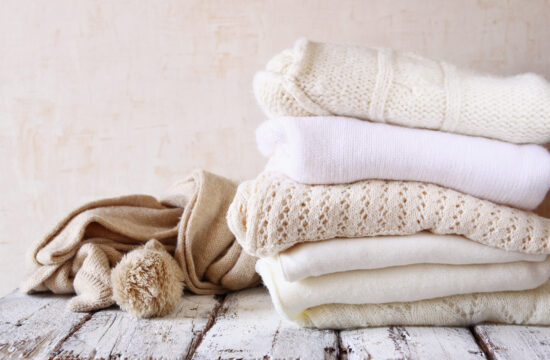What Exactly Is Knitwear?
Knitwear refers to garments made by weaving two sets of fabric and is one of the oldest forms of clothing on the planet. Although knitwear comes in a wide range of fabrics and fibers, the most popular varieties are wool, cashmere, and cashmere blends. Woolen garments and similar materials are pliable and can be easily misshapen or shrunk if washed incorrectly. Learn more about the different types of knitwear and how to care for them below.
Wool: Sheep’s wool is used to make a variety of garments, including sweaters, coats, and more. Wool is a popular choice for winter clothing because of its low heat-release rate and moisture-absorbing qualities. Despite its durability, wool is also malleable, allowing it to stretch out and shrink if not properly cared for.
Cashmere: Cashmere wool (or just cashmere) refers to the wool fibers from Kashmir goats used to make yarn, textiles, and clothing. Cashmere is known for its exceptionally soft feel; however, it is very fragile, meaning caring for it requires attention to detail to maintain its shape and quality.
Cashmere Blends: Blends of cashmere and wool offer a balance of comfort and durability. This blend is lightweight and comfortable, making it a favorite among many.
Does Knitwear Really Need Extra Care?
Knitwear requires a little more TLC than some of your other favorite clothes because of its delicate and stretchable material. Laundering them incorrectly or too frequently can cause them to shrink and lose their shape. Thankfully, correctly caring for knitwear is easy and can increase the lifespan of your favorite sweaters and garments. Learn more about how to care for your favorite knitted apparel below.
How to Properly Care for Knitwear

Caring for knitted clothing is a delicate operation; it could lead to undesirable results, such as shrinking and bubbling, if done incorrectly. While knitted garments can easily be damaged if washed with the rest of your laundry, there are easy ways to clean and store them to keep them looking new for a long time. Plus, you do not have to launder your knitwear as frequently as other fabrics, making them even easier to care for in the long run.
Washing Knitwear
Those who aren’t a big fan of laundry day will be delighted to learn that knitwear has self-cleaning properties, so you will not have to worry about washing knitted garments as often as your other clothes. Knitwear breathes well and does not absorb odors, so simply airing it out overnight is usually enough to refresh your favorite garments.
However, when you feel that your knitwear does require cleaning, you should always wash your favorite garments according to the care instructions on the label. If those aren’t available, hand washing it with cold water and a laundry detergent safe for wool is typically the way to go.
To wash your favorite knitwear by hand, soak it for 10 minutes before thoroughly rinsing it with clean water. Be sure to avoid harsh detergents and bleach, as they can damage the delicate material. Do not scrub knitted clothing too vigorously because it can cause stretching and surface wear.
Drying Knitwear
How you dry your knitwear also impacts how your favorite garments maintain their quality and shape. Never wring or hang-dry knitwear, as materials like wool can stretch out easily when drenched.
When drying a knitted garment, roll it up in a clean and dry towel before gently pressing down on it. After the towel absorbs the excess moisture, ease your knitwear back into shape and lay it flat on top of another dry towel or drying rack. Avoid placing your knitwear next to a heater to dry it faster, as too much heat can damage and shrink the delicate fibers.
Removing Stains From Knitwear
When responding to a stain emergency, it is a good idea to respond as quickly as possible. Always rinse stains ASAP with cold or lukewarm water first.
If rinsing alone does not work, try spot-cleaning the garment using a wool-friendly laundry detergent. To spot-clean a wool garment or other knitwear, add detergent to a dampened cloth and gently tap the stain without scrubbing or rubbing it.
Always avoid harsh stain removers to preserve the color and texture of your knitted clothing.
Storing Knitwear
Not only does knitwear stretch and deform easily, but it also makes a great meal for moths, meaning proper storage is crucial to ensuring a longer life for your favorite knitted clothing. The best way to store your knitted garments to avoid inviting pests like moths is to fold them neatly and store them on a shelf or in a dresser drawer, leaving space between them.
If you plan on storing your knitwear in a container outdoors, like in a shed or garage, consider adding dried cedar or lavender to protect them from moths. Be sure to gently shake out your knitwear occasionally during the summer months to air them out and deter any unwanted pests from getting to them while you’re away.
How ZIPS Can Help

At ZIPS, we take the hassle out of caring for your favorite knitted apparel and other delicate garments. We approach your favorite garments with the utmost care to maximize their longevity and keep you looking your best every day of the week.
Find a location near you, and let us take care of things today! And be sure to check out ZIPS tips for more information on how to launder your clothes to keep them looking like new.

